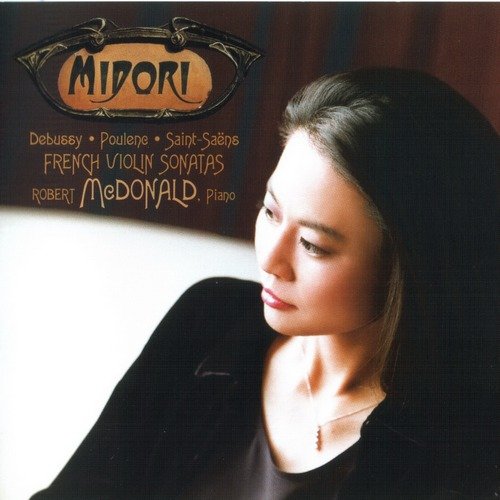Midori, Robert McDonald - French Violin Sonatas (2002)

Artist: Midori, Robert McDonald
Title: French Violin Sonatas
Year Of Release: 2002
Label: Sony Music
Genre: Classical
Quality: FLAC (image+.cue,log,scans)
Total Time: 53:19
Total Size: 250 Mb
WebSite: Album Preview
Tracklist: Title: French Violin Sonatas
Year Of Release: 2002
Label: Sony Music
Genre: Classical
Quality: FLAC (image+.cue,log,scans)
Total Time: 53:19
Total Size: 250 Mb
WebSite: Album Preview
Poulenc - Sonata for Violin and Piano (1943):
01. I. Allegro con fuoco
02. II. Intermezzo. Tres lent et calme
03. III. Presto tragico
Debussy - Sonata in G minor for Violin and Piano:
04. I. Allegro vivo
05. II. Intermede. Fantasque et leger
06. III. Finale. Tres anime
Saint-Saens - Sonata No. 1 in D minor for Violin and Piano, Op. 75:
07. I. Allegro agitato - Adagio
08. II. Allegretto moderato - Allegro molto
Performers:
Midori, violin
Robert McDonald, piano
Midori's dazzling recital of French violin sonatas on SACD trumps its CD companion (type Q5668 in Search Reviews) by the usual small margin in sound quality, but the improvements, here and elsewhere, justify the new medium's purpose, especially in music as subtly textured as these works. Already fine-sounding on CD, the SACD reveals more of the nuances in Midori's and accompanist Robert McDonald's exquisitely sensitive readings.
For one, the SACD not only opens the sound considerably, but the instruments themselves acquire a new sense of full-bodied bloom and separation, thanks to the increase in dynamic range. Along these lines, listeners may find the SACD also eliminates a slight "tinny" sound in the upper registers of the piano and violin, a possible result of the higher frequency-range limits of SACD and only apparent in direct comparison with the CD. Likewise, the weightiness of the piano's lower registers is restored, such that the concluding pedal tones in the Poulenc sound commanding and jarring. On SACD, the Debussy, already a primer of dynamic and rhythmic contrast in its CD incarnation, draws the listener in even further with a transparency and clarity that is rather astonishing, even on low-end systems.
A packaging ambiguity is the only real flaw of this new version. The jewel case itself is wrapped in an external casing with the generic "Stereo/Multichannel" bending across the front cover. A sticker declaring this disc to be "Stereo" proves to represent the truth; it is stereo only (and SACD-only, as the back of the disc will further confirm), so make sure you examine the disc from all sides to make sure you are compatible and not disappointed. -- Michael Liebowitz
For one, the SACD not only opens the sound considerably, but the instruments themselves acquire a new sense of full-bodied bloom and separation, thanks to the increase in dynamic range. Along these lines, listeners may find the SACD also eliminates a slight "tinny" sound in the upper registers of the piano and violin, a possible result of the higher frequency-range limits of SACD and only apparent in direct comparison with the CD. Likewise, the weightiness of the piano's lower registers is restored, such that the concluding pedal tones in the Poulenc sound commanding and jarring. On SACD, the Debussy, already a primer of dynamic and rhythmic contrast in its CD incarnation, draws the listener in even further with a transparency and clarity that is rather astonishing, even on low-end systems.
A packaging ambiguity is the only real flaw of this new version. The jewel case itself is wrapped in an external casing with the generic "Stereo/Multichannel" bending across the front cover. A sticker declaring this disc to be "Stereo" proves to represent the truth; it is stereo only (and SACD-only, as the back of the disc will further confirm), so make sure you examine the disc from all sides to make sure you are compatible and not disappointed. -- Michael Liebowitz

![Ben Aylon, Roei Hermon - SMALL ROOM IN DAKAR (2025) [Hi-Res] Ben Aylon, Roei Hermon - SMALL ROOM IN DAKAR (2025) [Hi-Res]](https://www.dibpic.com/uploads/posts/2025-12/1765640683_pl8lfacmwajwc_600.jpg)





![Sibel Köse Septet - In Good Company (2025) [Hi-Res] Sibel Köse Septet - In Good Company (2025) [Hi-Res]](https://www.dibpic.com/uploads/posts/2025-12/1765846644_uizwujac4ht2d_600.jpg)
